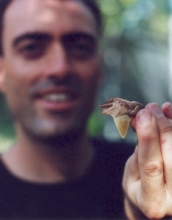News Release 07-013
Lizards Shout Against a Noisy Background to Get Points Across
Research shows how animals adapt their behavior to the environment

Lizards' signals must be strong enough for a rival to see without alerting predators.
February 21, 2007
This material is available primarily for archival purposes. Telephone numbers or other contact information may be out of date; please see current contact information at media contacts.
Male Anole lizards signal ownership of their territory by sitting up on a tree trunk, bobbing their heads up and down and extending a colorful throat pouch.
They can spot a rival lizard up to 25 meters away, says National Science Foundation (NSF)-funded biologist Terry Ord of the University of California at Davis. Ord and colleagues published their results this week in the journal Proceedings of the Royal Society B.
The lizards' signals need to be strong enough for a rival to see, but not vivid enough to interest predators.
Their forest homes, however, can be "visually noisy" environments, with branches and leaves waving in the breeze.
"They have to have a strategy to get their message across," Ord says.
"We all know that people speak more loudly in a noisy party," says John Byers, program director in NSF's division of organismal systems. "These researchers have shown that lizards can do the same. We are only beginning to understand how perfectly adapted the behavior of animals can be."
Ord videotaped two species of Anole lizards, Anolis cristatellus and Anolis gundlachi, in the Caribbean National Forest of Puerto Rico.He found that the more "noise" in the background, the faster and more exaggerated the movements of the lizards.
Anole lizards are interesting to evolutionary biologists because different species are found on different islands throughout the Caribbean. The lizards are not closely related -- they are separated by 30 million years of evolution -- but they live in similar environments with the same obstacles to communication.
Co-authors of the paper are Richard Peters, Australian National University, Canberra, and Barbara Clucas of the University of California at Davis. The work was also supported by grants from the National Geographic Society and the Australian Research Council.
-NSF-
Media Contacts
Cheryl Dybas, NSF, (703) 292-7734, email: cdybas@nsf.gov
Andy Fell, UC-Davis, (530) 752-4533, email: ahfell@ucdavis.edu
The U.S. National Science Foundation propels the nation forward by advancing fundamental research in all fields of science and engineering. NSF supports research and people by providing facilities, instruments and funding to support their ingenuity and sustain the U.S. as a global leader in research and innovation. With a fiscal year 2023 budget of $9.5 billion, NSF funds reach all 50 states through grants to nearly 2,000 colleges, universities and institutions. Each year, NSF receives more than 40,000 competitive proposals and makes about 11,000 new awards. Those awards include support for cooperative research with industry, Arctic and Antarctic research and operations, and U.S. participation in international scientific efforts.
Connect with us online
NSF website: nsf.gov
NSF News: nsf.gov/news
For News Media: nsf.gov/news/newsroom
Statistics: nsf.gov/statistics/
Awards database: nsf.gov/awardsearch/
Follow us on social
Twitter: twitter.com/NSF
Facebook: facebook.com/US.NSF
Instagram: instagram.com/nsfgov


